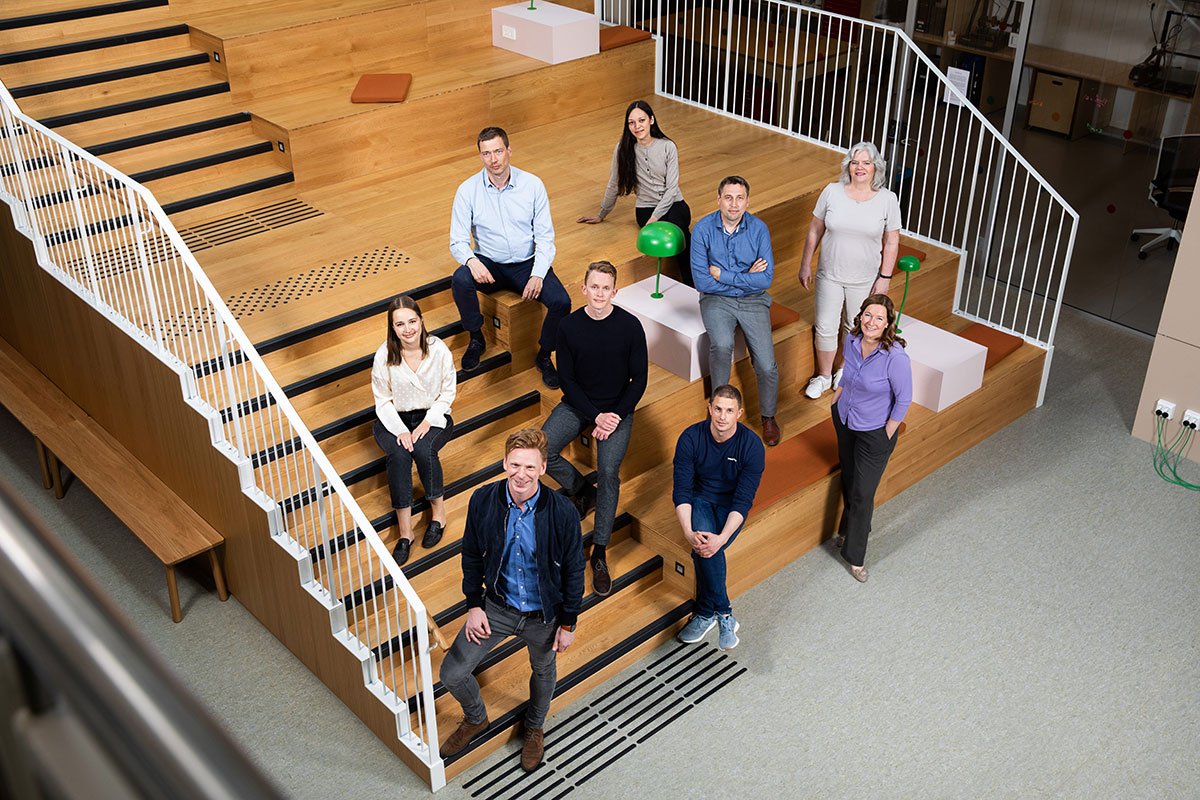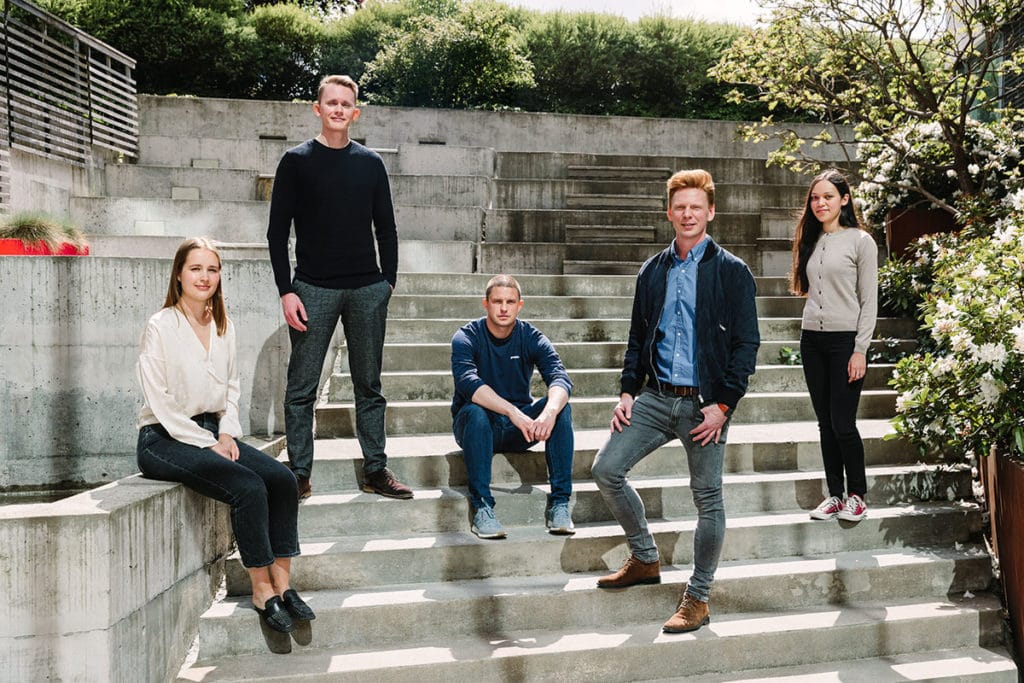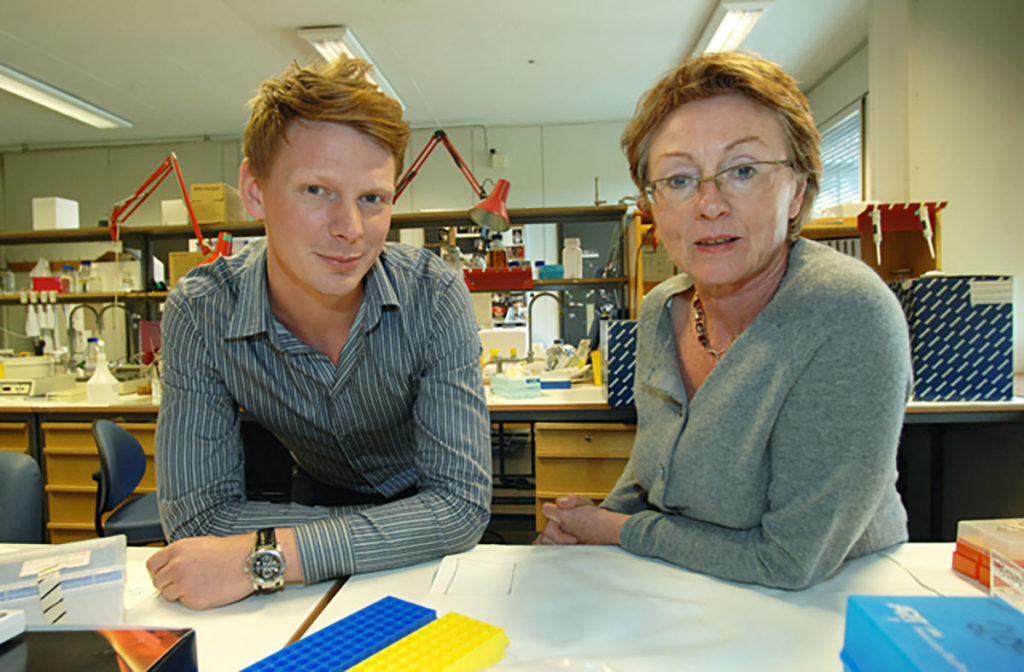Innovation motivated by patients
Jan Terje Andersen learnt about laboratory work when he was studying to become a biomedical laboratory scientist. Scientific curiosity led him to the Department of Biosciences at the University of Oslo. A lecture by Professor Inger Sandlie decided his future career. Today, he is one of the researchers with the most innovations at Inven2.
By Elisabeth Kirkeng Andersen
Jan Terje Andersen waits by the entrance of a building in front of the main building at Rikshospitalet University Hospital. We are to be shown to the fourth floor, where his research group has its offices and laboratories.
– In 2014, I received a career grant from the Research Council of Norway. I was then part of Inger Sandlie’s research group at the Centre for Immune Regulation (CIR), a Centre of Excellence. Since then, I have built a solid group of 15 dedicated researchers. I was lucky to get Inger on board as well,’ says Andersen.
Jan Terje Andersen and Inger Sandlie can be described as a dream team in outstanding research and innovation. They have cooperated since 2002.
– Inger was my supervisor, then she became a good friend, a partner and a mentor. She is clear and reflective. We challenge each other and are open to each other’s opinions,’ says Andersen.
More on that, later.
Motivated by the patients
At Inven2, the numbers are clear – Andersen is a researcher and innovator.
He is part of:
- 65 innovations
- 11 patent families
- 50 industry agreements, covering product sales, cooperation agreements and licences for patents
– Why should researchers innovate? Nobody can do your research better than you can. It almost goes without saying that the opportunity should be seized when it comes along. If our research can improve the everyday life of patients, ease severe symptoms or cure illness — that would be fantastic,’ says Andersen and continues:
– The innovation process is both challenging and unpredictable, but also very motivating when we believe the work will lead to results.
However, Andersen is clear that research-driven innovation is not for everyone.
– Innovation work is not something you can make all researchers do. But we all have a responsibility to speak up when we eye an opportunity. I believe it’s important that efforts are made to facilitate the work of researchers engaged in this process,’ says Andersen.
He refers to an article he recently wrote for Khrono, in which he called for a shift in funding. You can read it here. This article delves into a great many things, but it is not about research policy.
Tailored antibodies
‘The Laboratory of Adaptive Immunity and Homeostasis’ is the name of Andersen’s research group. It is part of both the University of Oslo and Oslo University Hospital.
Its core activity is related to research and research-driven innovation on antibodies and a protein called albumin. See the fact box for an explanation of antibodies and albumin.
Facts:
Antibodies are proteins that are produced by white blood cells when foreign substances such as viruses and bacteria are detected in the body. The foreign substances are composed of antigens, and the body produces antibodies particularly designed to target certain antigens, like a key in a lock. The body is therefore always packed with antibodies, we are talking billions, and they circulate both in the blood stream and cover the mucous membranes.
Albumin is the body’s carrier molecule. It means that the protein carries nutrients and residual products in the blood to be delivered to different cells and organs. It has a long lifespan, a unique property that makes it an interesting candidate for pharmaceuticals.
– We’re trying to understand the connection between structure and function. Our point of departure is molecular design. By means of genetic modification, we are changing the antibodies and albumin’s composition and properties. These modified proteins are our tools, which we use to unravel biology and determine why we develop serious illnesses. Furthermore, we make use of the knowledge to design protein variants that can be tailored to different treatments,’ says Andersen.
In order to translate the research results into solutions that benefit patients, Andersen’s research group cooperates closely with Inven2.
Fruitful collaboration with Inven2
Jan Terje Andersen cooperates with a broad team of people at Inven2, which consists of Gerbrand Koster, project manager for Andersen’s projects, Eivind Roverud on patenting and intellectual property rights, Kristin Sandereid on business development and Helle Thorsen, who draws up contracts and agreements.

Jan Terje with colleagues and cooperation team in Inven2. Back row from left: Gerbrand Koster (Inven2), Siri Sakya. Middle row from left: Simone Mester, Torleif Tollefsrud Gjølberg, Eivind Roverud (Inven2), Helle Thorsen (Inven2). Front row from left: Jan Terje Andersen, Stian Foss, Kristin Sandereid (Inven2). Photo: Moment Foto.
– I work closely with Inven2. The cooperation started when I was one of Inger’s young and hopeful students. The organisation was called Birkeland Innovasjon back then. I’m in constant, almost daily, contact with my team there. They are an integral part of our everyday research work,’ says Andersen.
When he recently hired more researchers, he invited the team from Inven2 to the group meeting.
– It’s important that everyone who works here forms a relationship with their own technology transfer office. The researchers must know what Inven2 can assist with, who they can get in touch with, and what an innovation process entails,’ says Andersen.
He believes that understanding the different roles is key to good collaboration and a common understanding of the social responsibility.
– I’m inspired by our research forming the foundation for new medical technology. This enthusiasm for what research results can actually lead to, how they can be used to benefit patients, is my main motivation,’ says Andersen and continues:
– Then I can take on different kinds of work like contacting companies and attending conferences to find the right partners. I see that same drive in Inven2’s employees, and together we complement each other.
Gerbrand Koster is full of enthusiasm for Andersen and his research group.
– Jan Terje and his colleagues are very capable. They manage to secure research funding, get published in good scientific journals, receive international attention and they are good at innovation. They are also active on social media and present at conferences the world over. We have good partnership and work closely together, says Koster.
Found “The Missing Link”
– Come meet some of the researchers, says Andersen.

Jan Terje and his group. From the left: Simone Mester, Torleif Tollefsrud Gjølberg, Stian Foss, Jan Terje Andersen og Siri Sakya. Photo: Moment Foto.
Algirdas Grevys is the first researcher I greet. He is back from spending a year at the Roche Innovation Centre in Munich as part of his postdoctoral period financed by the global pharmaceutical company, Roche.
– ‘Algirdas has developed a cellular system, which is known in the field as «the missing link». Many people have attempted to develop it, without success. Algirdas did it,’ says Andersen.
The unique system is used to provide insight into how antibodies and albumin variants are absorbed, broken down or saved from breakdown in cells. This is very useful information that can be used in the design of new antibodies and albumin-based pharmaceuticals.
Grevys’ work has led to a host of other partnerships with biotechnology companies.
Andersen initially got in touch with Roche at a conference, which is often the case with industry.
From eyes to HIV and cancer
– This is Torleif, says Andersen.
Torleif Gjølberg Tollefsrud is working in a laboratory with a beautiful view of the Grefsenkollen area. He is a research fellow and part of an interdisciplinary team, which includes doctors from the Department of Ophthalmology at Ullevål Hospital. The project with the ophthalmologists has resulted in savings of NOK tens of millions for the hospital. Han er doktorgradsstipendiat og er del av et tverrfaglig team som inkluderer leger ved Øyeavdelingen på Ullevål sykehus. Read more about it here.
Inside, by the laboratory bench, researcher Siri Sakya doesn’t have time to talk, but waves happily. She sits immersed over colourful pipettes and test tubes. Out in the corridor, we bump into researcher Stian Foss. Siri and Stian are working together on an international cooperative project that was awarded NOK 19 million in funding in 2019 from the Research Council of Norway’s ‘Programme for Global Health and Vaccination Research’, GlobVac. Its goal is to develop the next generation of antibodies to fight HIV. Han og Siri jobber sammen på et internasjonalt samarbeidsprosjekt som i 2019 fikk 19 millioner kroner i finansiering gjennom Forskningsrådets program «Global helse- og vaksinasjonsforskning», GlobVac. Målet er å utvikle neste generasjon antistoffer mot HIV.
– In the project, we use unique technologies that we have developed. This is an important project for us, as it has a global health dimension and can help vulnerable women and children in developing countries. Stian is about to embark on a one-year research stay at Scripps Research Institute in California where he will continue his work on antibodies,’ says Andersen.
Simone Mester is sitting on the couch outside the laboratory. She is taking her doctoral degree in extending the half-life of a group of antibodies that might prove effective in cancer treatment.
– Hello, nice to see you again, says Simone.
She is a member of SPARK, an innovation programme at the University of Oslo, and a former pupil of Ullern upper secondary school. While attending the school, she participated in the school cooperation with Oslo Cancer Cluster, and is now a mentor on the research programme’ at the school. You can read more about her research here and here. Du kan lese mer om forskningen hennes her og her.
«Basic research is a precondition for innovation»
We return to Jan Terje’s office. I want to hear more about how and why he enjoys so much success in his field.

Jan Terje and Inger in the lab in 2019. Photo: Ola Sæther/Uniforum.
– One of my criteria for success is that I enjoy working as part of a team and surround myself with students, researchers and clinicians who have the skills and knowledge that enable us to complement each other in our work towards a common goal, says Andersen and continues:
– I have also established a diverse international network over the years, with researchers from both academia and industry. This is important to succeed in innovation.
He is also competitive, enjoys filling out applications and knows how to attract funding and retain talented researchers. These are skills he shares with Sandlie. I tillegg har han konkurranseinstinkt, liker å skrive søknader og er god på å få inn midler og holde på forskertalentene. Evner han deler med Inger Sandlie.
So, how did the two of them become such a dream team?
– The whole thing started with a lecture by Inger on the secrets of immunology. It was a fascinating and demanding subject. I was impressed by the complexity, but I also recognised the implications for disease and treatment, says Andersen.
He knocked on Sandlie’s office door and asked politely whether he could take a second degree in the subject, and the rest is history. The degree programme looked at biotechnological production of a protein that governs the long-term effect of albumin and antibodies of the type IgG in the blood. The aim was to express the protein in bacteria. After a lot of trial and error, they succeeded. A newer version of the protein is currently being sold by a Danish biotechnology company.
– Inger had an international network and contact with the industry. She took me along to meetings where I quickly learnt what to say and what not to say to stimulate interest in cooperation, says Andersen.
It was followed by a doctoral degree under the supervision of Sandlie, and a post-doctoral position as part of the Centre for Immune Regulation. Andersen and Sandlie’s research moved from Blindern to Rikshospitalet University Hospital, where they work today.
– It was incredibly motivating to be part of an ambitious and goal-oriented centre where everybody focused on immunology. The focus was on long-term work and perspectives. I quickly made contact with research communities outside the centre, both locally and at the hospital, and I got access to infrastructure. All of this has been decisive for my research and innovation work, says Andersen.
He also learnt that there is no conflict between good basic research and innovation, rather the opposite.
– Innovation requires good basic research. Only by unravelling how everything is connected in detail, can we tailor a new treatment, says Andersen and continues:
– I want to invite both patients and next of kin to our group meetings to a greater extent. It makes us reflect and recognise the importance of our work. Researchers like us need to meet those who we might one day be able to help, thanks to the molecular jigsaw we are constantly trying to solve.
